
- Troll
- Part One - A Wikipedia Research
- Monstropedia
- This article is about the trolls of folklore. For Wikipedia trolls, see Wikipedia:What is a troll. For other uses, see Troll (disambiguation).
Nordic literature, art and music from the romantic era and onwards has adapted trolls in various manners – often in the form of an aboriginal race, endowed with oversized ears and noses. From here, as well as from Scandinavian fairy tales such as Three Billy Goats Gruff, trolls have achieved international recognition, and in modern fantasy literature and role-playing games, trolls are featured to the extent of being stock characters.
Scandinavian folklore
The meaning of the word troll is uncertain. It might have had the originally meaning of supernatural or magical with an overlay of malignant and perilous. Another likely suggestion is that it means "someone who behaves violently". In old Swedish law, trolleri was a particular kind of magic intended to do harm. It should be noted that North Germanic terms such as trolldom (witchcraft) and trolla/trylle (perform magic tricks) in modern Scandinavian languages does not imply any connection with the mythical beings. Moreover, in the sources for Norse mythology, troll can signify any uncanny being, including but not restricted to the Norse giants (jötnar).
In Skáldskaparmál, the poet Bragi Boddason encounters a troll-woman who hails him with this verse (in Old Norse):
|
|
The ambiguous original sense of the word troll appears to have lived on for some time after the Old Norse literature was documented. This can be seen in terms such as sjötrollet (the sea troll) as a synonym for havsmannen (the sea man) – a protective spirit of the sea and a sort of male counterpart to the female sjörå (see huldra).
There are many places in Scandinavia that are named after trolls, such as the Swedish town Trollhättan (Troll's bonnet) and the legendary mountain Trollkyrka (Troll church). The most famous in Norway are Trollfjorden, Trollheimen, Trollhetta, Trollstigen, Trolltindan and Trollveggen.
Gradually, we can discern the forming of two main traditions regarding the use of troll. In the first tradition, the troll is large, brutish and a direct descendant from the Norse jötnar. They are often described as ugly or having beastly features like tusks or cyclopic eyes. This is the tradition which has come to dominate fairy tales and legends (see below), but it is also the prominent concept of troll in Norway. As a rule of thumb, what would be called a "troll" in Norway would in Denmark and Sweden be a "giant" (jætte or jätte, derived from jötunn).
In some Norwegian accounts, such as the middle age ballade Åsmund Frægdegjevar [3], the trolls live in a far northern land called Trollebotten – the concept and location of which seems to coincide with the Old Norse Jötunheimr.
The second tradition is most prominent in southern Scandinavia. Reversely, what would be called trolls in southern Sweden and Denmark would be called huldrefolk in Norway and vitterfolk in northern Sweden (see wight). The south-Scandinavian term probably originate in a generalization of the terms haugtrold (mound-troll) or bergtroll (mountain-troll), as trolls in this tradition are residents of the underground.
These trolls are very human-like in appearance. Sometimes they had a tail hidden in their clothing, but even that is not a definite. A frequent way of telling a human-looking troll in folklore is instead to look at what it is wearing: Troll women in particular were often too elegantly dressed to be human women moving around in the forest.
More often than not, though, the trolls kept themselves invisible, and then they could travel on the winds, such as the wind-troll Ysätters-Kajsa, or sneak into human homes. Sometimes you could only hear them speak, shout and make noise, or the sound of their cattle. Similarly, if you were out in the forest and smelled food cooking, you knew you were near a troll dwelling. The trolls were also great shapeshifters, taking shapes of objects like fallen logs or animals like cats and dogs. A fairly frequent notion is that the trolls liked to appear as rolling balls of yarn.
Whereas the large, ogrish trolls often appear as a solitary being, the "small" trolls were thought to be social beings who lived together, much like humans except out in the forest. They kept animals, cooked and baked, were excellent at crafts and held great feasts. Like many other species in Scandinavian folklore, they were said to reside in underground complexes, accessible from underneath large boulders in the forests or in the mountains. These boulders could be raised upon pillars of gold. In their living quarters, they hoard gold and treasures. Opinion varied as to whether or not the trolls were thoroughly bad or not, but often they treated people as they were treated. Trolls could cause great harm if vindictive or playful, though, and regardless of other things they were always heathen. Trolls were also great thieves, and liked to steal from the food that the farmers had stored. They could enter the homes invisibly during feasts and eat from the plates so that there was not enough food, or spoil the making of beer and bread so that it failed or did not end up plentiful enough.
The trolls sometimes abducted people to live as slaves or at least prisoners among them. These poor souls were known as bergtagna ("those taken to/by the mountain"), which also is the Scandinavian word for having been spirited away. To be bergtagen does not only refer to the disappearance of the person, but also that upon returning, he or she has been struck with insanity or apathy caused by the trolls. Anyone could be taken by the trolls, even cattle, but at the greatest risk were women who had given birth but not yet been taken back to the church.
Occasionally, the trolls would even steal a new-born baby, leaving their own offspring – a (bort)byting ("changeling") – in return.
To ward off the trolls you could always trust in Christianity: Church bells, a cross or even words like "Jesus" or "Christ" would work against them. Like other Scandinavian folklore creatures they also feared steel. Apart from that they were hunted by Thor, one of the last remnants of the old Norse mythology, who threw Mjolnir, his hammer, causing lightning bolts to kill them. Though Mjolnir was supposed to return to Thor after throwing, these hammers could later be found in the earth (actually Stone Age axes) and be used as protective talismans.
Fairytales and legends
While the everyday folklore consisted mostly of short anecdotes describing things that had (supposedly) happened to local people, fairytales are narratives that rarely claim to be true in the same way. Many of the fairytales featuring trolls were written in the late 19th century to early 20th century, reflecting the romanticism of the time, and published in fairytale collections like Tomtar och Troll. These tales, and illustrations by artists like John Bauer and Theodor Kittelsen, would come to form the ideas most people have of trolls today.Legends from the Middle Ages and earlier also feature a kind of trolls of more horrifying dimensions. This might reflect a past view of trolls as distinctly bad creatures that would soften in later folklore (see the above), or just be another example of fantastic tales demanding fantastic dimensions.
In fairytales and legends trolls are less the people living next to humans and more frightening creatures. Particularly in these tales they come in any size and can be as huge as giants or as small as dwarves. They are often regarded as having poor intellect (especially the males, whereas the females, trollkonor, may be quite cunning), great strength, big noses, long arms, and as being hairy and not very beautiful (Once again, females often constitute the exception, with female trolls frequently being quite comely). In Scandinavian fairy tales trolls sometimes turn to stone if exposed to sunlight, a myth generally attributed to pareidolia found in naturally eroded rock outcrops.
Asbjørnsen and Moe's collection feature a number of traditional fairy tales where trolls hold princesses captive, such as The Three Princesses of Whiteland, Soria Moria Castle, and Dapplegrim, and two where trolls invade homes on Christmas Eve to make merry, Tatterhood and The Cat on the Dovrefell. Female trolls may conspire to force the prince to marry their daughters, as in East of the Sun and West of the Moon, or practice witchcraft, as in The Witch in the Stone Boat, where a troll usurps a queen's place, or The Twelve Wild Ducks, where she turns twelve princes into wild ducks. In other tales, the hero matches wits with the troll: Boots and the Troll, and Boots Who Ate a Match With the Troll.
The following excerpts from the Danish Ballad of Eline of Villenskov describe the physical aspects of trolls within Scandinavian mythology:
- There were seven and a hundred Trolls,
- They were both ugly and grim,
- A visit they would the farmer make,
- Both eat and drink with him.
- Out then spake the tinyest Troll,
- No bigger than an emmet was he,
- Hither is come a Christian man,
- And manage him will I surelie.
Origin of the myth
In the genre of paleofiction, the distinguished Swedish-speaking Finnish paleontologist Björn Kurtén has entertained the theory (e.g. in Dance of the Tiger) that trolls are a distant memory of an encounter with Neanderthals by our Cro-Magnon ancestors some 40,000 years ago during their migration into northern Europe. Spanish paleoanthropologist Juan Luis Arsuaga provides evidence for these types of encounters in his book, The Neanderthal's Necklace. The theory that Neanderthals and Cro-Magnons occupied the same area of Europe at the same time in history has been theorized based on fossil evidence. Other researchers believe that they just refer to neighboring tribes. The problem with this theory is that neither Neanderthals or Cro-Magnons existed in this part of Europe during the ice-age. Most of Scandinavia was covered by a large glacier and the area was not occupied until much later.A more plausible explanation for the troll myth, is that the trolls represent the remains of the forefather-cult which was ubiquitous in Scandinavia until the introduction of Christianity in the 10th and 11th centuries. In this cult the forefathers were worshipped in sacred groves, by altars or by gravemounds. One of the customs associated with this practice was to sit on top of a gravemound at night, possibly in order to make contact with the deceased. With the introduction of Christianity however, the religious elite sought to demonize the pagan cult, and denounced the forefathers as evil. For instance, according to Magnus Håkonsen's laws from 1276 it is illegal to attempt to wake the "mound-dwellers". It is in these laws that the word troll appears for the first time, denoting something heathen and generally unfavourable.
This fits with the trolls in Norse sagas who are often the restless dead, to be wrestled with or otherwise laid to rest.
Nordic art, music and literature
Edvard Grieg, the most important Norwegian composer of the later 19th century, wrote several pieces on trolls, including a score based on Henrik Ibsen's Peer Gynt, with the famous In the Hall of the Mountain King, and March Of The Trolls. Regarding his motivations, Grieg wrote: "The peculiar in life was what made me wild and mad...dwarf power and untamed wildness...audacious and bizarre fantasy." Grieg's former home, Troldhaugen ("The Troll's Hill"), is now a museum. [4][5]Like Grieg, conductor Johan Halvorsen was a nationalist Norwegian composer. He wrote, The Princess and the Giant Troll, The Trolls enter the Blue Mountain, and Dance of the Little Trolls.
Geirr Tveitt was heavily influenced by Grieg's romanticism and cultural exploration of Scandinavian folklore and Norwegian folk-music. Tveitt's Troll Tunes, includes works such as Troll-Tuned Hardanger Fiddle, and The Boy With The Troll-Treasure. Tragically, 80% of Tveitt's oeuvre was destroyed in a fire.
In Swedish children's literature, trolls are not naturally evil, but primitive and misunderstood. Their misdeeds are due to a combination of basic and common human traits, such as envy, pride, greed, naïveté, ignorance and stupidity. In some early 20th century fairy tales, by Elsa Beskow, trolls are also depicted as an aboriginal race of hunters and gatherers who are fleeing the encroaching human civilisation. Where man makes a road, the trolls disappear.
Young Scandinavian children usually understand the concept of trolls, and a way to teach children to brush their teeth is to tell them to get rid of the very small "tooth trolls" that otherwise will make holes in their teeth. This is a pedagogic device used to explain bacteria by the Norwegian author Thorbjørn Egner in his story Karius and Baktus.
The Swedish-speaking Finnish author Tove Jansson has reached a world-wide audience with her Moomintrolls.
There is some speculation that the famous story Rumpelstiltskin originated from a troll folk tale which bears many similarities. While the original story of the troll involves a preacher contracting a troll to build a church as opposed to a woman needing to spin straw into gold, the central element of a bargain which is satisfied by guessing the name of the involved party, and the subsequent death of the troll or being whose name is guessed is central to both stories. (see Fin (troll))
Heavy metal music
Some modern heavy metal bands, notably Finntroll and Trollfest, members of a genre sometimes known as "troll metal". Essentially a form of folk metal or viking metal, troll metal exchanges the pagan or Nordic lyrics and themes of these genres with imagery of trolls, goblins and other such creatures.Gallery
A gallery of trolls as imagined by various Nordic artists.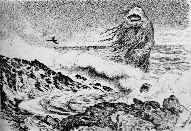 The sea troll (Theodor Kittelsen, 1887). |  Forest troll. (Theodor Kittelsen, 1906). | 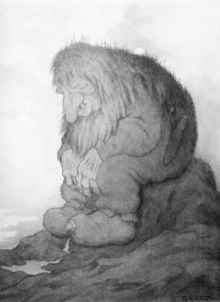 Troll pondering its age. (Theodor Kittelsen, 1911). | 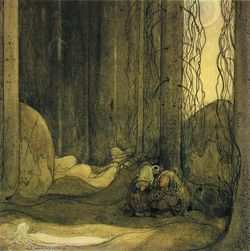 The changeling (John Bauer, 1913). |
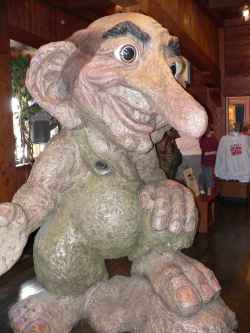 Statue of a troll at the Norwegian pavilion in Epcot, Walt Disney World Resort. | 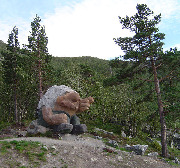 Troll statue in the forest near Geilo, Norway. | Norwegian road sign - beware of trolls |  Cover of the Finntroll album Midnattens Widunder, featuring a troll. |
See also:
- Gourmander, painting by Hasse Bredenberg http://runeberg.org/bredberg/ http://home.tiscali.se/visater/bredenberg/.
- Världens största Trollmålning, mural by Rolf Lidberg http://www.pinocchioamarcord.it/pinocchio_troll_2.htm.
- Trold, der vejrer kristenblod http://www.kid.dk/VarkBillede.asp?objectid=13759 http://www.vejenkunstmuseum.dk/Dansk/samlingen/nhj/skulpturer/trolden.htm, sculpture by Niels Hansen Jacobsen.
- The moomintrolls of Tove Jansson.
















No comments:
Post a Comment